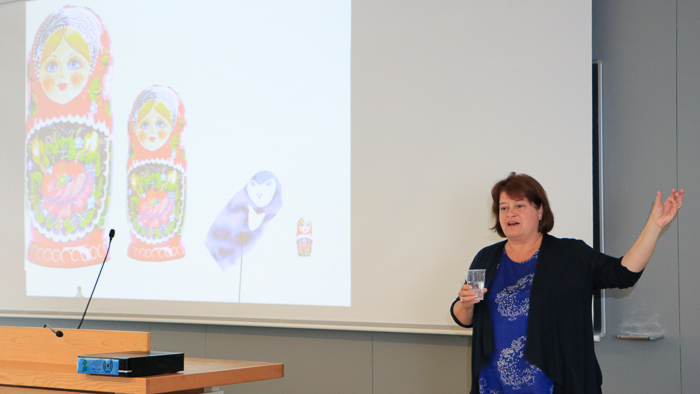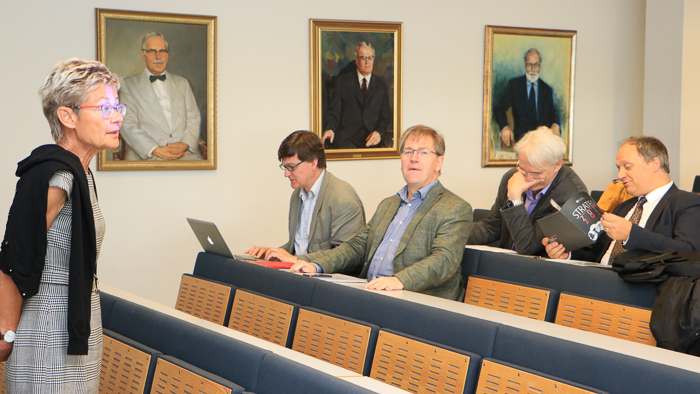Coimbra Group: Sharing Best Practices in Interdisciplinary Research
20.09.2016
Social sciences and humanities meeting of the Coimbra Group was organised at the University of Turku 15–16 September 2016. Researchers gathered together to share best practices in interdisciplinary research.

Professor Veronica Strang reminded that even though we are now talking about a new direction, interdisciplinary research is in fact about finding academic roots. However, this requires that you trust others with your own area of expertise.
Strang visited the social sciences and humanities meeting of the Coimbra Group held at the University of Turku. Coimbra Group is an association of long-established European multidisciplinary universities of high international standard committed to creating academic and cultural ties between universities. Its purpose is also to influence European educational policy and to develop best practices through universities' mutual exchange of experiences.
Interdisciplinary research has been chosen as the theme in Turku. Dean Eija Suomela-Salmi from the Faculty of Humanities opened the Sharing best practices in interdisciplinary research seminar and noted that these days, both the complexity of problems and funding guide researchers towards more interdisciplinary research.
– In addition to these facts, interdisciplinary research is intellectually inspiring. When you have to look at something from a new perspective and explain your views with other scientific language than your own, you are forced to evaluate things in a new way, said Suomela-Salmi.
Professor Veronica Strang, who had been invited as the keynote speaker, encouraged everyone to become radicals. Strang, an anthropologist working as the Head of the Institute of Advanced Study at the Durham University, pictured the university world as a Matryoshka doll. The smallest doll was an individual researcher and the bigger dolls moved on from subject to faculty and the greater science community.
– In order for individual researchers to advance in their science community and receive funding, it is easiest not to stand out from the crowd. However, it is intellectually more interesting and fun to be radical. It changes the way you think. I can admit that my research has not been the same after interdisciplinary co-operation, said Strang.
Humanists Invite Everyone to Join Interdisciplinary Research

According to Eija Suomela-Salmi (pictured on the left), boundaries between scientific disciplines have been actively crossed at the University of Turku. For example, researchers from the Faculty of Humanities have been co-operating with researchers from the Faculty of Mathematics and Natural Sciences and Faculty of Nursing Science. This work was presented to members of the Coimbra Group. Co-operation is not locked only to these three, everyone is welcome to join.
– In case someone is interested in co-operation, do not hesitate to contact us, noted Suomela-Salmi.
The Durham unit led by Strang was established 10 years ago as a separate unit with its own budget and faculty-like structure. It chooses an annual theme and gathers researchers from different scientific disciplines around it. Themes have included, for example, water, time, light and scale. The theme for next year is structure.
In the beginning, the researchers from the University of Durham induced other researchers they knew from around the world to join, now researchers are chosen through an application process.
– We choose the theme by first collecting ideas, then refining them in small groups and in the end, we send five proposals to a wider audience for evaluation. When the theme has been chosen, researchers can send their applications and we choose the best ones, explains Strang.
According to Strang, interdisciplinary co-operation has required letting go of old prejudices. Quantitative and qualitative, subjective and objective, local or big data based, hard and soft data are all definitions that are not evaluated against one another.
– We have also drafted an evaluation guide for evaluating interdisciplinary research. It works both as a check list when launching a new project and as proof that interdisciplinary research exists, said Strang.
Text and photos: Erja Hyytiäinen
Translation: Saara Yli-Kauhaluoma